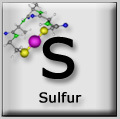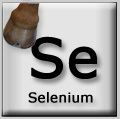Sulphur, Selenium


As part of the amino acids cysteine and methionine, sulfur is found in virtually all proteins. The functional groups of these amino acids (thiolate group in cysteine and thioether in methionine) are often used as protein coordination sites for metal atoms.
Typical thiophilic metals in biomolecules are zinc, copper and tungsten (also known are specific mechanisms for removing toxic heavy metals from cells, c.f. mercury detoxification protein).
Iron-sulfur clusters participate in numerous electron transfer reactions and are thus a main component of many enzymes. The oxidation of thiol groups takes place in the physiological range; the thus formed disulfide bridges are common in proteins.
The metabolism of H2S, which is accompanied by the release of elemental sulfur, represents an archaic form of biological energy production.
Selenium is an important trace element, which is found in a number of enzymes (although usually in low concentrations). The biological significance of selenium is very likely quite diverse and goes beyond its originally identified role as a free-radical scavenger.
Selenium has a very small therapeutic range. That means that both too much and too little selenium have serious negative effects.
Too little selenium typically causes the Keshan disease (heart weakness by youths in selenium poor regions). Too much selenium can cause hoof disease in animals which graze in selenium rich areas.
